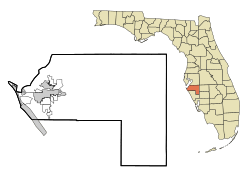Fort Hamer, Florida facts for kids
Quick facts for kids
Fort Hamer, Florida
|
|
|---|---|
|
Unincorporated community
|
|
| Fort Hamer | |
| Country | United States |
| State | Florida |
| County | Manatee |
| Established | November 28, 1849 |
| Elevation | 7 ft (2 m) |
| Time zone | UTC-5 (EST) |
| • Summer (DST) | UTC-4 (EDT) |
| Area code(s) | 941 |
| FIPS code | 12-23895 |
| GNIS feature ID | 295293 |
Fort Hamer is an area in Manatee County, Florida, United States. It's called an "unincorporated area" because it's not officially part of a city or town. The name comes from a military fort that existed there for a short time. Even today, no one has found the exact spot where the old fort was located.
Contents
Fort Hamer's Story
Building the Fort
Fort Hamer was first built on November 28, 1849. This happened because Major General David E. Twiggs gave an order. He wanted to set up forts across Florida. This was to help manage conflicts between settlers and some Seminole groups.
The fort was part of a line of forts. This line stretched about 200 miles (320 km) from the Manatee River to the Indian River.
Who Was Fort Hamer Named After?
The fort was named after Thomas L. Hamer. He was a brigadier general in the army. A brigadier general is a high-ranking military officer. General Hamer was also a strong supporter of Andrew Jackson, who was a U.S. President.
Life at the Fort
When it was first built, Fort Hamer had several log buildings. These included a hospital and a place to store food (called a commissary). There was also a hay barn and living areas for soldiers. About 165 soldiers could stay there.
The Fort's Short Life
The line of forts built by General Twiggs didn't last long. They were abandoned only one year after they opened.
However, Fort Hamer was used again in 1856. This was during the Third Seminole War. A small group of 10 soldiers from the Florida Mounted Volunteers were stationed there.
When the Fort Closed
Twenty-seven years after it was first built, Fort Hamer was officially closed. On February 26, 1876, the War Department handed the property over. It went to the Department of the Interior. These are both parts of the U.S. government.
By 1895, nothing was left of the fort itself. The area was known as a sandy spot on the Manatee River. It was a popular place for boating and day trips.


